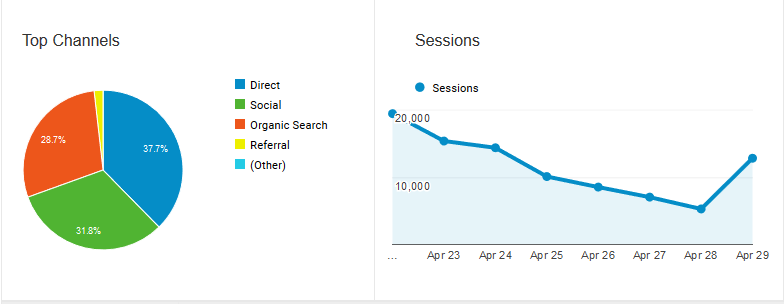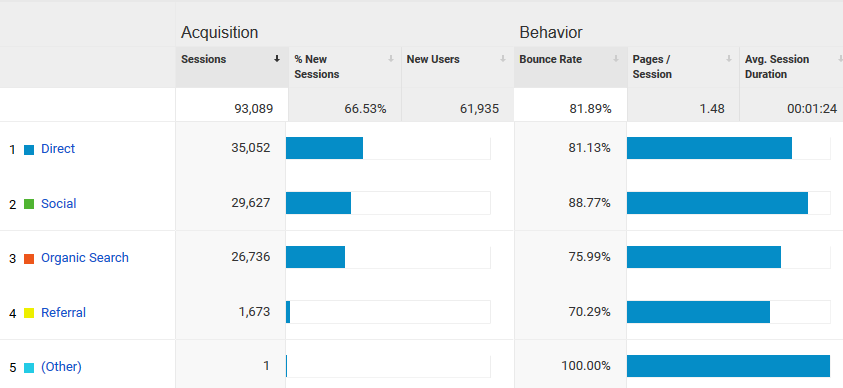Being steamrolled by web traffic is a problem many small businesses wish they had.
Landing on an Oprah list, being retweeted by a Kardashian or having your website mentioned on the Howard Stern Show would sure be nice, but the reality is that we all have to work really hard to get visitors to notice us. With over 300 marketing messages bombarding our brains every day, is it any wonder that we filter out nearly all of it? One of the underlying rules for making all your online marketing channels effective is that they must lead to engaging content. Content marketing is challenging, time-consuming and competitive. Advertising is a guessing game at best (think Don Draper’s rejected ideas on Mad Men). You could spend countless hours and a great deal of money to obtain minimal results. Alternatively, you could work smarter with your content and see fantastic returns. Content marketing isn’t exactly optional anymore, so if you want more traffic, you need to invest in distributing valuable content. Capturing an internet user’s attention requires a smart strategy around building “lead magnets” (noteworthy content), promoting it across a variety of channels and then maximizing your returns. So content is king, but ATTENTION is more important. Let’s take a look at attention getting lead magnets and how you can get more visitors to your website.
The average human attention span in 2015
8.25 seconds
The average attention span of a gold fish
9.00 seconds
[/rs_feature_box][rs_space height=”12px”]
ONRAMPS: TRAFFIC SOURCES
Hopefully you regularly review your Google Analytics (or Clicky) reports to observe the health of your online presence. If you do, you’ll probably recognize the Channels report (one you should check with regularity).

As a basic framework, Google Analytics divides traffic into a few key channels:
Direct Traffic
Someone types in your URL (they got your business card or saw your late night infomercial on television).
Organic Search
Your SEO guru optimized your blog and website so that when someone types in “best company ever”, you were on page one of Google.
Social
In between catching up with old college friends and sharing pictures of your burrito, perhaps you post something about your company that links to your website.
Your email marketing campaigns are properly configured to show Google that that’s what they are.
Paid
Your $3000 monthly spend on Google AdWords had better be showing up somewhere in Google Analytics.
Referral
Links from other websites, particularly important other websites, are your biggest, bestest friend.
DELIVERY: FEEDING YOUR TRAFFIC CHANNELS
How do you feed ORGANIC traffic?
Create a content plan and execute on it. Pay attention to search engine optimization techniques before, during and after you create the content.
- Website Copy
- Products & Services
- Industry-related Information
- Content Marketing
- Blogs
- Vlogs
- Shadow Landing Pages
- Press Releases
- Search Engine Optimization
How do you feed EMAIL traffic?
Do you have a newsletter? Create some useful content and share it with your list on a regular basis. Be sure your newsletter links are tagged as an email source, or Google will put it into the DIRECT channel (and it’s inaccurate). Use UTM campaign tagging if you need to (note, MailChimp and Constant Contact have settings to flag email). Pro Tip: resend any newsletters a few days later to the UNOPENED list with a new subject line.
- Newsletters
- Announcements
- Onboarding emails
- Holiday e-cards
- Reminders
- Email signature
How do you feed SOCIAL traffic?
Post regularly. If you create content, promote it about 15-20% of the overall volume of your social posts. Connect with others on social – it’s about conversations, not just machine gun posting your sales material. Comment on other posts, retweet, engage.
- Facebook Post, Groups
- LinkedIn Post, Groups
- Google+, YouTube
How do you feed DIRECT traffic?
In a word, go outside. Direct traffic is typically from face-to-face communication, like when you give someone a business card at a conference or networking event.
- Networking
- Trade Shows/Conferences
- Speaking Engagements
- Traditional Media
- Television
- Radio
- Product packaging
- Customers/Web application
How do you feed PAID traffic?
If you don’t have one, get your credit card out and set up an AdWords account. Try a few simple, small-budget tests to learn about keywords, budgets and audiences. You can try social platforms too: Facebook, LinkedIn and Instagram are relatively easy to try. If you get stuck, ask around for colleagues who have run campaigns and get some tips.
- Google AdWords
- Facebook/Instagram
- Sponsorships
How do you feed REFERRAL traffic?
Ah, the holy grail… The hardest but most rewarded effort is from getting backlinks from other sites.
- Guest Blog Post
- Viral Marketing
- Influencers
- Affiliate Marketing
- Partnerships/Sponsorships
How do you start content marketing?
Research
We’ve written about personas before, and they’re a factor in all marketing communications. So if you know your audience, you need to ask and answer “what do they want or need?”. We recommend looking through your FAQs as a starting point. What questions do you get on the front line? What are your customers’ biggest hassles and concerns? For example, we at Twisted Puppy write about things like calls to action and creating good value propositions. 🙂
For search engines, you may want to spend some time digging around for good keywords to match with your content ideas. There are some great tools to determine what language people use to find your content. Start with the basics, but get as specific as you can. Keep the semantics in mind – it’s not a jacket, it’s a dog jacket, or it’s web design in Manhattan Beach rather than web design.
Keyword Tools
Moz.com
Google Keyword Planner
KeywordTool.io
Create
As you design your content, consider the channels you’ll be using to spread your message. Where do your “right customers” hang out? Is it Facebook? Is it the exotic car website? RELEVANCY MATTERS.
Be sure you give the audience what they want – deliver the right message in the right place at the right time. When you create your content, it must be “customer first”. Tell interesting stories, provide statistical backup and align everything to the customer’s perspective. Yes, you may have a beautiful internal corporate mission statement, but customers’ eyes glaze over reading them. WIIFM. What’s In It For Me. Your message is more powerful if it’s customer-centric.
We love building “lead magnets” into our content marketing programs. We have thousands of examples of files we have downloaded and tried for many areas of our business. Lead magnets are things like:
- Checklists
- Downloads
- Worksheets
- Toolkits/resource guides
- Mini-courses
- Podcasts
- Webinars
- Videos
We’ve seen debates (and done it both ways) with respect to “gated content” versus “ungated content”. We like to give a little, then ask a little. That is, we give away the first piece of content without requiring an email address. But then we give away something more sophisticated that does ask for an email address (and sends the content via an autoresponder if a valid email address is provided). Some call this the “foot in the door method”. Consider content upgrades (more than what you include in the original material) as well – the first level of your video course is risk-free, but the detailed version asks for more.
Polish
Once you’ve made some good, useful content, you should add a layer of polish. We prefer adding great visuals (eye-catching images, charts, infographics), many of which we build as we create the content initially. Look for ways to cross-link your content to other posts or sections of your website, leading the visitor to your sales funnel. And of course you should enable sharing the content (can someone easily post it to Facebook, Twitter and LinkedIn?).
DANDELION SEEDS: PROMOTE YOUR CONTENT
A quiet personality sure isn’t what you need to attract attention.
– Bill Budge (Game programmer for Apple)
Next, the focus of your marketing should be to canvas those channels we mentioned at the beginning of this article. Make sure you maximize (without overdoing it) the reach of your content. The ratio of time may be scary, but you should promote across at least eight channels, creating “dandelion seeds” for your content. Your time investment should be 1 part creation and 4 parts promotion (80/20 rule!)
Broadcast to your email list.
Send a newsletter if you have a list, or individual emails if you want to keep it personal. Note, you are six times more likely to get a click from an email campaign than a tweet.
Reach out on social media.
Where does your audience spend its time – Facebook, Instagram, Pinterest, Twitter, Google+? Target each social media platform with the appropriate level of promotion. Post at various times. Don’t use the same post repeatedly. Start with the title of your content, then mix in a quote, a key benefit, your thoughts or comments from your content.
- Facebook Groups
- LinkedIn Pulse
- LinkedIn Groups
- Google+
Consider options with paid media.
With a small budget, you can promote your content to a specific audience for a limited time.
- Facebook Ads/boost post
- Twitter Ad
- Instagram Ad
- Google AdWords
- Sponsored Website
Syndicate your content.
Do you have a place where you can contribute a guest blog that would be visible in your market? Can you get it in the hand of market influencers who could use it or share it?
Repeat.
Without violating reasonable ratios of self-promotion, cycle through your promotion – once is not enough. We’ve always advocated for 1 in 8 social media posts being self-promotion, so mix retweets, likes, comments and shares with your announcements.
Hint: your audience tunes you out if every post is ME – ME – ME.
POLISH: MEASURE. RINSE. REPEAT.
Hopefully you’re investing a bit of time each week or month in reviewing your website’s analytics reports. Where is your traffic coming from? What pages are being hit most often? What keywords are driving the most valuable traffic? Analytics data serves as your compass. If something is working, do more of it. If something you want to be successful is floundering, see if you can improve it. Analytics data tells you what, but you’ll need to experiment to find why… Polish your content regularly. Even old posts can gain new life with a review and update. Think long-term about your content.
LEAD MAGNETS: Attracting Attention to Your Website
Creating lead magnets is a solid strategy for building website traffic. Good, expandable content is key, with an eye toward ensuring that your content is easily found (and hopefully shared with others). Pushing your message into various channels is essential, but this practice is often overlooked or underutilized. If a particular channel works better than others, use it more. If another channel isn’t working, experiment with messaging and media to see if you can improve. As we said, consider that your content works like a dandelion. You create it, then put it out into the wind to grow further…
Putting it all together, here are the keys to success:
- Consider success metrics.
What matters most for your business - Create a content plan.
We love editorial calendars! - Build “conversion” into your content (lead capture).
What are content upgrades you can offer based on the content? Your goal is to turn “strangers” into prospects! - Plan distribution before publication.
Know where you’re going to promote and set it up before you publish. - Measure (use UTMs, if needed).
You MUST keep score on what you’re doing to know if it works. - Experiment.
Try different messages and media in your content and your distribution channels. - Stick with it!
The hardest part…it requires nurturing over time. How many blogs do you see that were going well for 2 months, and then….
Get Our List of 10 Great Lead Magnet Ideas
(with Links & Examples)
[mc4wp_form id=”2507″]






![Video Engagement [Infographic]](https://twistedpuppy.com/wp-content/uploads/2017/08/twisted-puppy-blog-video-engagement-1-500x383.png)


Leave A Comment